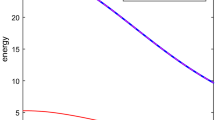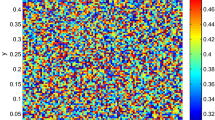Abstract
In this work, the MMC-TDGL equation, a stochastic Cahn-Hilliard equation, is solved numerically by using the finite difference method in combination with a convex splitting technique of the energy functional. For the non-stochastic case, we develop an unconditionally energy stable difference scheme which is proved to be uniquely solvable. For the stochastic case, by adopting the same splitting of the energy functional, we construct a similar and uniquely solvable difference scheme with the discretized stochastic term. The resulted schemes are nonlinear and solved by Newton iteration. For the long time simulation, an adaptive time stepping strategy is developed based on both first- and second-order derivatives of the energy. Numerical experiments are carried out to verify the energy stability, the efficiency of the adaptive time stepping and the effect of the stochastic term.
Similar content being viewed by others
References
Cahn J W, Hilliard J E. Free energy of a nonuniform system, I: Interfacial free energy. J Chem Phys, 1958, 28: 258–267
Cao H Y, Sun Z Z. Two finite difference schemes for the phase field crystal equation. Sci China Math, 2015, 58: 2435–2454
Chakrabarti A, Toral R, Gunton J D, et al. Dynamics of phase separation in a binary polymer blend of critical composition. J Chem Phys, 1990, 92: 6899–6909
Chen W B, Conde S, Wang C, et al. A linear energy stable scheme for a thin film model without slope selection. J Sci Comput, 2012, 52: 546–562
Chen W B, Wang C, Wang X M, et al. A linear iteration algorithm for a second-order energy stable scheme for a thin film model without slope selection. J Sci Comput, 2014, 59: 574–601
Chin J, Coveney P V. Lattice Boltzmann study of spinodal decomposition in two dimensions. Phys Rev E, 2002, 66: 016303-1–016303-8
Copetti M I M, Elliott C M. Numerical analysis of the Cahn-Hilliard equation with a logarithmic free energy. Numer Math, 1992, 63: 39–65
de Gennes P G. Dynamics of fluctuations and spinodal decomposition in polymer blends. J Chem Phys, 1980, 72: 4756–4763
Eyre D J. An unconditionally stable one-step scheme for gradient systems. Http://www.math.utah.edu/~eyre/ research/methods/stable.ps
Eyre D J. Unconditionally gradient stable time marching the Cahn-Hilliard equation. In: Bullard J W, Kalia R, Stoneham M, et al., eds. Computational and Mathematical Models of Microstructural Evolution. Mater Res Soc Symp Proc, vol. 529. Warrendale: Materials Research Society, 1998, 39–46
Flory P J. Principles of Polymer Chemistry. New York: Cornell University Press, 1953
Furihata D. A stable and conservative finite difference scheme for the Cahn-Hilliard equation. Numer Math, 2001, 87: 675–699
Furihata D, Matsuo T. A stable, convergent, conservative and linear finite difference scheme for the Cahn-Hilliard equation. Japan J Indust Appl Math, 2003, 20: 65–85
Glotzer S C, Paul W. Molecular and mesoscale simulation methods for polymer materials. Annu Rev Mater Res, 2002, 32: 401–436
He Y N, Liu Y X, Tang T. On large time-stepping methods for the Cahn-Hilliard equation. Appl Numer Math, 2007, 57: 616–628
Huang J Y. Numerical study of the growth kinetics for TDGL equations. Master’s Degree Thesis. Ontario: The University of Western Ontario, 1998
Huang T, Xu H G, Jiao K X, et al. A novel hydrogel with high mechanical strength: A macromolecular microsphere composite hydrogel. Adv Mater, 2007, 19: 1622–1626
Ibañes M, García-Ojalvo J, Toral R, et al. Noise-induced phase separation: Mean-field results. Phys Rev E, 1999, 60: 3597–3605
Kawakatsu T. Computer simulation of self-assembling processes of a binary mixture containing a block copolymer. Phys Rev E, 1994, 50: 2856–2862
Li J, Sun Z Z, Zhao X. A three level linearized compact difference scheme for the Cahn-Hilliard equation. Sci China Math, 2012, 55: 805–826
Li X, Ji G H, Zhang H. Phase transitions of macromolecular microsphere composite hydrogels based on stochastic Cahn-Hilliard equation. J Comput Phys, 2015, 283: 81–97
Liu C, Shen J, Yang X F. Decoupled energy stable schemes for a phase-field model of two-phase incompressible flows with variable density. J Sci Comput, 2015, 62: 601–622
Liu C H. Stochastic Process, 4th ed. Wuhan: Huazhong University of Science and Technology Press, 2008
Nocedal J, Wright S J. Numerical Optimization. New York: Springer-Verlag, 1999
Qiao Z H, Sun S Y. Two-phase fluid simulation using a diffuse interface model with Peng-Robinson equation of state. SIAM J Sci Comput, 2014, 36: B708–B728
Qiao Z H, Sun Z Z, Zhang Z R. Stability and convergence of second-order schemes for the nonlinear epitaxial growth model without slope selection. Math Comp, 2015, 84: 653–674
Qiao Z H, Tang T, Xie H H. Error analysis of a mixed finite element method for the molecular beam epitaxy model. SIAM J Numer Anal, 2015, 53: 184–205
Qiao Z H, Zhang Z R, Tang T. An adaptive time-stepping strategy for the molecular beam epitaxy models. SIAM J Sci Comput, 2011, 33: 1395–1414
Saad Y, Schultz M H. GMRES: A generalized minimal residual algorithm for solving nonsymmetric linear systems. SIAM J Sci Stat Comput, 1986, 7: 856–869
Shen J, Wang C, Wang X M, et al. Second-order convex splitting schemes for gradient flows with Enhrich-Schwoebel type energy: Application to thin film epitaxy. SIAM J Numer Anal, 2012, 50: 105–125
Sun Z Z. A second-order accurate linearized difference scheme for the two-dimensional Cahn-Hilliard equation. Math Comp, 1995, 64: 1463–1471
Wang C, Wang X M, Wise S M. Unconditionally stable schemes for equations of thin film epitaxy. Discrete Contin Dyn Syst, 2010, 28: 405–423
Wise S M. Unconditionally stable finite difference, nonlinear multigrid simulation of the Cahn-Hilliard-Hele-Shaw system of equations. J Sci Comput, 2010, 44: 38–68
Wise S M, Wang C, Lowengrub J S. An energy-stable and convergent finite-difference scheme for the phase field crystal equation. SIAM J Numer Anal, 2009, 47: 2269–2288
Xu C J, Tang T. Stability analysis of large time-stepping methods for epitaxial growth models. SIAM J Numer Anal, 2006, 44: 1759–1779
Zhai D, Zhang H. Investigation on the application of the TDGL equation in macromolecular microsphere composite hydrogel. Soft Matter, 2013, 9: 820–825
Zhang S, Wang M. A nonconforming finite element method for the Cahn-Hilliard equation. J Comput Phys, 2010, 229: 7361–7372
Zhang W, Li T J, Zhang PW. Numerical study for the nucleation of one-dimensional stochastic Cahn-Hilliard dynamics. Commun Math Sci, 2012, 10: 1105–1132
Zhang Z R, Ma Y, Qiao Z H. An adaptive time-stepping strategy for solving the phase field crystal model. J Comput Phys, 2013, 249: 204–215
Author information
Authors and Affiliations
Corresponding author
Rights and permissions
About this article
Cite this article
Li, X., Qiao, Z. & Zhang, H. An unconditionally energy stable finite difference scheme for a stochastic Cahn-Hilliard equation. Sci. China Math. 59, 1815–1834 (2016). https://doi.org/10.1007/s11425-016-5137-2
Received:
Accepted:
Published:
Issue Date:
DOI: https://doi.org/10.1007/s11425-016-5137-2




